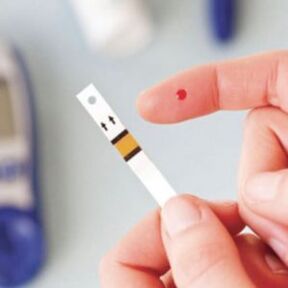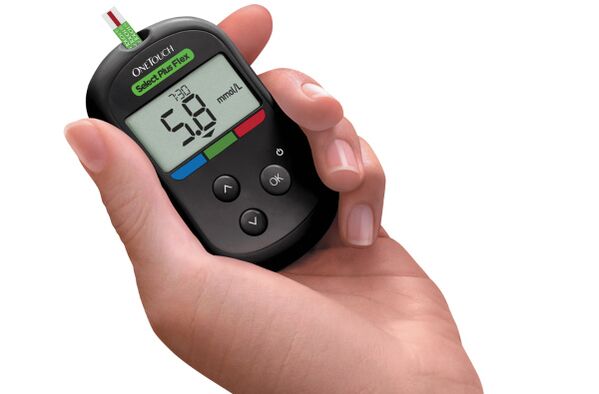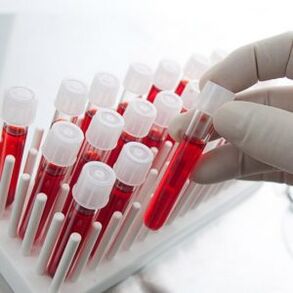
Symptoms of diabetes are a set of clinical manifestations specific to certain diseases, which indicate doctors and patients to the occurrence or development of pathological processes.
Diabetes mellitus is recognized as one of the most common diseases in the world, today 350 million people around the world have suffered. According to statistics, in just two decades, the number of cases increased more than 10 times. About 90% of these people - second type diabetes.
If you identify the pathology in the early stages, you can avoid a large number of severe complications. That is why it is important to know what is on the onset of the disease, and how one should be examined to control this severe endocrine pathology.
The manifestation of diabetes does not depend on its type. The human body can understand when adequate energy levels stop the glucose needed in this case, into the result of its metabolism, and it remains in the abundance of blood flow, causing irreversible hazards to the system and organs. The metabolic processes that are interrupted in the body are provided by insulin deficiency, which is responsible for the process of glucose metabolism. But the characteristics of the first and second type of diabetes pathogenesis have a significant difference, so it is important to know exactly the symptoms.
The main symptoms
Insulin deficiency in blood or decreased cell sensitivity that depends on insulin to insulin action in the body leads to high glucose concentration in the blood. In addition to these symptoms, considered to be the main diabetes, there are other signs detected during the patient's medical observation. In the event of a slight suspicion of the presence of the disease, it should seek medical help, as the early detected disease is subject to treatment, and in the modern world, even when school children are beginning to experience diabetes.
The first manifestation

As the first manifestation of diabetes, doctors call some specific symptoms. In diabetes, patients always have polyuria - fast and abundant urine, due to glycemia and glucose levels in the urine. It is a glucosuria which is a cause that prevents the absorption of fluid by the kidney structure. Poliuria is always accompanied by thirst where one can take up to 10 liters of liquid daily.
Despite the use of so much liquid, there is always a feeling of dry mouth. If the second type of diabetes, together with thirst, continuous hunger appears. This is due to the fact that insulin produced by the pancreas in large quantities in the blood and is not used by its purpose, signals to the brain about hunger.
High levels of glycemia cause serious harm to the body. Nerve fiber damage causes polyneuropathy diabetes. The first sign of such a complication is the numbness of the fingers -the feet and the hands and the pain in the limbs. If you start acting on the blood glucose level on time, the development of this process can be stopped and the pain syndrome if you do not stop at all, it will interfere with it. However, if you miss the onset of pathological development, you can wait for severe consequences - severe pain, conservation, trophic ulcer and more.
With damage to the high glycemia of the eye, diabetes angiopathy develops. Clinically, initially, the disease is characterized by a sense of cloud with a high concentration of glucose in the blood, thus a decrease in visual acuity and even complete blindness in the absence of therapy. Any occurrence of the above symptoms, and more of their complex, should force the patient to be immediately examined to detect insulin deficiency.
External manifestations
Among the external signs are also showing high insulin and glycemia resistance. For example, such symptoms can be a sharp development of dry skin, itching and peeling. It is very important to pay attention to such skin manifestations to the same thirst background. Also, with diabetes, itching occurs frequently on the mucous membranes of the mucus, due to the irritating effects of glucose contained in the urine. There is no release at the same time, which is a feature of its own diabetes.
Also, a sharp weight loss is the first type of diabetes. In this case, it is necessary to observe some of the other pathological symptoms so as not to make a rush. Excessive obesity and weight are not symptoms of second type diabetes, but can act as a cause. However, if a person's weight changes quickly everywhere without a clear reason, he or she should pay attention to this and undergo a doctor's examination.
Symptoms of diabetes
The first type

The first type of diabetes is very fast in its development. He has a particular manifestation of payable.
The patient has an increased appetite in his history, but he only loses weight, tired, drowsiness. Regular encouragement does not allow the toilet at night to sleep quietly, forcing them to get up several times. The amount of urine in this case increases significantly, as the thirst is over.
Such symptoms are unknowingly, as they occur very sharply and suddenly. It is accompanied by severe nausea, vomiting and irritation. It is very important to pay attention to the ongoing encouragement to the toilet at night in children, if this is not observed before.
The main problem with the first type of diabetes is the fact that glucose levels can also increase blood and decrease very sharply. Both states are dangerous for health and have their own characteristics and manifestations, which must be carefully monitored.
The second type
The most common is the second type of diabetes. The manifestations are very diverse, they look gradually, so it's hard to catch and recognize them immediately. Mild symptoms usually do not lead to the fact that a person, after finding it at home, begins to sound the alarm immediately.
The second type of diabetes is characterized by the occurrence of dry mouth, thirst, urine, weight loss, fatigue, weakness and drowsiness. The characteristics of these various diseases are the presence of tingles in the fingers and numbness of the limbs, hypertonic manifestations, infectious processes in the urinary system. Similarly, the first type of diabetes of the patient can be interrupted by nausea and vomiting, dryness and itching -skin, and skin infections.
It is important to remember that the development of symptoms gradually leads to the development of the disease itself. Diabetes at a later stage is full of complar hyperosmolar, lactoacidosis, ketoacidosis, hypoglycemia, which gets momentum in hours and can even cause the patient's death. In addition, due to advanced diabetes, patients often experience serious vision problems, then lead to blindness, kidney or heart failure, vascular and nervous system pathology.
During pregnancy

Diabetes pregnancy sugar is rarely indicated by certain external signs. Often, his presence is found with planned examinations that are carried out regularly for pregnant women. The main indicators are data from blood and urine tests.
With the presence of external signs of pregnancy disease, they are all very similar to the symptoms of diabetes of the first two types -nausea, vomiting, weakness, thirst, infections in the genitourinary system are not separate signs of toxic and other pathology, but shows in the second and third trimester of pregnancy.
The pathology of pregnancy is a direct threat to the life of a mother or child, but it can affect the general course of pregnancy, the well -being of the future, and the fetus.
High blood pressure in glucose leads to high -weight baby (more than 4 pounds), which in the future will be a prerequisite for obesity or diabetes at any age. Delays in the development of children, hypoglycemia, yellow in the first pores of newborn life can also be created.
Signs -to complications
The feet of diabetes
Diabetes feet in medicine are understood as anatomical changes and comprehensive functioning in the distal tissue of the lower leg in diabetic patients. This is the greatest complication of the pathology that is considered, often leading to gangrene, amputation of members and defects.

If there is a history of diabetes in foot health, you should be monitored very carefully. There are three main forms of diabetes: neuropathic (major nerve damage), ischemia (major blood vessels and blood flow disorders), mixed.
Among the complaints of patients before diabetes, experts distinguish unpleasant feelings, burns and sensations of stitches in the legs, goosebumps, current discharge. If such symptoms disappear while walking, this indicates the onset of the development of neuropathic forms of diabetes. It is also important to pay attention if periodic sensitivity is lost. If a painful sensation arises directly during walking or at night (you can convince only by destroying members from the edge of the bed), this means the onset of the development of diabetes ischemia called "ischemic foot".
Among the signs that indicate the onset of diabetes, experts distinguish skin on the feet or spots -pigment spots, peeling and dry skin in this zone, multi -caliber bubbles on the skin with glossy, small bones in the feet. If a person is aware of at least some of these signs, he or she should seek medical help immediately.
Sign of retinopathy
Ophthalmology diabetes is characterized by changes in the blood vessels in the retina, leading to a violation of micro -circulation. Such violations lead to the occurrence of diabetes retinopathy. Such complications develop gradually and even in the later stages, it is almost invisible to a person.
The main signs of diabetes retinopathy are:
- the appearance of "flies" in front of the eyes;
- blurred vision;
- decrease in visual acuity at a later stage;
- Bleeding in vitreous and retinal body.
In this case, ophthalmology diabetes can be manifested in two main forms - non -Spheret (background), or retina retina retina. With background retinopathy, pathological anxiety, first of all, the retina itself. In the event of a violation of the retinal capillaries, bleeding, retinal swelling, and deposition of metabolic products. The background of retinopathy is a characteristic of older patients with diabetes. It causes a gradual decrease in visual acuity.
Based on the background, proliferative retinopathy is developing if the lack of osigal support increases. In this case, there is a new blood vessel pathology that grows from the retina to the vitreous body. This process leads to bleeding in the vitreous body and the development of sharp vision in a person and irreversible blindness. In adolescence, the transition of complications from one form to another can occur in a few months, so the retinal detachment and complete vision loss will be followed.
Signs -to Encephalopathy

Diabetes encephalopathy occurs as a complication of diabetes, due to degenerative damage to the brain. The prevalence of encephalopathy depends directly on the type of diabetes, and the symptoms - during the disease and its severity. It belongs to late complications and manifests itself 10-15 years after the manifestation of diabetes.
The immediate cause of the development of encephalopathy is a typical metabolic disorder of diabetes, which causes damage to the brain and blood vessels. The above process leads to a violation of brain activity, a decrease in cognitive function. The development of encephalopathy occurs very slowly, leading to the difficulty of detecting symptoms in the early stages.
The main symptoms of diabetes encephalopathy are:
- headache and dizziness;
- Emotional instability, high fatigue, sleep disorders and other neurasthenic disorders;
- human style instability;
- Bifuration of objects when looking at them, nebula of vision, "flies" in front of the eyes;
- mental disorders, depression;
- confused awareness;
- deterioration of mental activity, memory, ability to concentrate;
- stroke, temporary ischemic attack, other pathology of cerebral circulation;
- Seizures.
In the early stages, there were no clinical complications, and with the development of encephalopathy, the symptoms began to appear clearer. Symptoms are the same as both types of diabetes.
Frequent diabetes satellites are atherosclerosis, arterial hypertension and obesity. In relation to the pride of blood vessels in the event of atherosclerosis, the risk of ischemic stroke and heart attack increases. In the event of a violation of micro -circulation in the renal vessel, irreversible renal failure occurs, which eventually leads to complete cessation of kidney function. This, in turn, leads to the need for kidney failure replacement therapy with lifelong dialysis methods.
Diabetes coma
Diabetes cats mean serious disruption to the metabolic processes in the body of the patient suffering from diabetes. A coma can occur with a strong increase, and with a strong decrease in human blood sugar.
This condition requires immediate medical treatment, because in its absence, serious complications and possible death.

The coma grows gradually, but is quite fast. The first sign of a meeting that can be fictional conditions, rapid growth of blood sugar, nausea and vomiting, drowsiness, abdominal pain daily or more before a coma immediately. Another symptom of diabetes can be the odor of acetone from the patient's mouth. Sensitivity can also occur in seizures, thirst, thirst.
With hypoglycemic coma, the concentration of blood sugar decreases significantly. The indicator can reach a mark of 2. Among the obvious symptoms such as coma, unreasonable anxiety, fear of the patient, weakness, cramps, blood pressure, and loss of consciousness. Hypoglycemic coma precursors can be:
- general malaise;
- lack of appetite;
- diarrhea or constipation;
- Dizziness, headache, tachycardia.
Lack of aid in the state can lead to very serious consequences. As hypoglycemic coma is growing rapidly, the help provided should be urgent.
The sudden decrease in blood pressure in the patient, weakening the pulse, and the softness of the eyeball may indicate a sharp decrease in blood pressure. Only qualified doctors can bring someone to the state of the state, so an ambulance call should be followed as soon as possible.
Signs -The lab

You can know the diagnosis of the patient only after all the required laboratory tests. Any laboratory test for diabetes is intended to determine blood glucose indicators.
It is possible to accidentally identify sugar in the blood by examining a person's mass before being hospitalized or with an emergency of other indicators.
The most common is blood test for sugar, on an empty stomach. Before delivery, there is nothing to eat for 8-12 hours. Also, you cannot drink alcohol and you cannot smoke an hour before blood donations. Level of up to 5. 5 mmol a liter will be considered a normal indicator. If the indicator is equal to 7 mmol a liter, the patient will be sent for additional examinations. For this purpose, they are tested for glucose tolerance. For this, the patient contributes blood on an empty stomach, so he drinks a glass of water with sugar (75 grams for adults for 200 milliliters of water), and 2 hours later he goes beyond blood tests.
If the body is in normal condition, then the first analysis will show a result of up to 5. If the indicator is in the range, respectively, 5. 5-6. 7 and 7. 8-11. 1 mmol a liter, this will tell the doctor about the pre-antibetal development in the patient. Indicators beyond this number indicates diabetes.
It is also the custom to conduct a study on glycerin hemoglobin, showing the average value of human glucose for the last 3 months of life. Norms are indicators below 5. 7%. If the value is between 5. 7-6. 4%, this shows that there is a risk of type 2 diabetes mellitus. In this case, steps should be discussed with a doctor to reduce the risk. If the level of glycated hemoglobin is more than 6. 5%, the diagnosis of diabetes is possible, but it requires confirmation. The recommended hemoglobin levels in people with diabetes are less than 7%, if this level is higher, it is necessary to discuss the situation with your doctor. Keep in mind that the level of glycerin hemoglobin above 7% can be estimated by doctors as optimal.
Symptoms of children
Diabetes can be clear at any age, including early children. Even newborn diabetes is found. This is a rare case of natural diseases. Often, manifestations in children contribute 6-12 years. The metabolic processes in children during this period are going faster, and the condition of the non -formed nervous system can affect the glucose level in the blood. Younger babies, more complicated diabetes.
Among the main symptoms that parents need to pay attention to not to release the development of diabetes in children, doctors distinguish:
- thirst and dry mouth;
- nausea with vomiting;
- frequent urine with urine fatigue;
- high weight loss and appetite at the same time;
- the fall of visual acuity;
- High fatigue, weakness and irritation.
If children have at least one of the above symptoms, this is the reason for finding a doctor. If some symptoms are detected, at the same time, the doctor should be immediately.
Also among the symptoms of children, the signs of normal and unusual diabetes. Doctors -Doctors who describe the typical symptoms that parents are often confused with age -related urinary incontinence, polydipsy, polyphagic, dryness and itching -skin, itching -gematics after urination, blood sugar amount more than 5. 5 per liter when blood tests are tested. Timely diagnosis in cases of suspicion will help identify the disease early and start the necessary therapy, which will not allow complications to develop.
Determination of diabetes mellitus at home
Diabetes courses can be symptomless. It can be identified randomly when visiting the optometrist or any other doctor. However, there are many signs in which the presence of pathology can be formulated independently. Moreover, at home, you can accurately establish a type of disease.
With a healthy body, after eating in the blood, the sugar level increases. After 2-3 hours later, this indicator should return to its original border. If this does not happen, then one has some unseen symptoms. These are considered dry mouth, thirst, very frequent and abundant urine, increased appetite, indifference, cramps, consciousness. Gradually, one began to see the dryness of the skin, which was previously not real.
Also at home, you can suspect the occurrence of diabetes on a variety of strange sensations that a person has not seen before. In the second type of diabetes, this is a weak wound healing and scratches, the development of obesity. In the first type of pathology, a person, on the other hand, can significantly lose weight, although the appetite is relatively high. In addition, with all types of diseases, itching can occur, increased hair growth in the face, xanth formation (small yellow growth on the skin), hair loss on the limbs and others.
The identification of timely diabetes signs should cause a doctor.
Only if you start therapy for diabetes in the early stages, we can hope for compensation for the disease and the quality of life in the future.
























